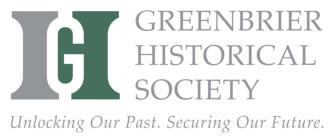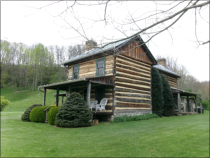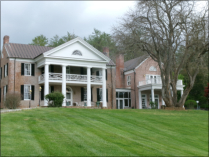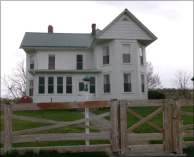















“Alderson’s Longest Running News Media”

Contact:
Executive Director 304-645-3398
Margaret Hambrick, Secretary 304-646-2439
814 West Washington Street
Lewisburg, WV 24910
304-645-3398
NEWS RELEASE
HOME TOUR SITES ANNOUNCED


Founded
in
1963,
the
Greenbrier
Historical
Society
is
dedicated
to
community
enrichment
through
education
and
preservation
of
the
history
and
culture
of
the
Greenbrier
Valley.
The
Greenbrier
Historical
Society
is
a
regional
organization
that
serves
the
West
Virginia
counties
of
Greenbrier,
Monroe,
Summers,
and Pocahontas.



The
Greenbrier
Historical
Society
is
planning
an
exceptional
historic
Home
Tour
Weekend
in
the
Frankford/Renick
area
of
the
Greenbrier
Valley.
The
weekend
will
begin
with
a
presentation
by
Dr.
Sarah
McCartney
at
6:00
p.m.
on
Friday,
June
13,
in
the
auditorium
of
the
New
River
Community
and
Technical
College
with
refreshments
on
the
lawn
at
the
North
House,
and
conclude
on
Saturday,
June
14
with
the
Home
and
History
Tour
from
10-4
pm.
This
is
a
major
fundraiser
for
GHS
and
virtual
tickets
for
all
events
as well as ticket packages are available on the GHS website
https://bit.ly/ghshometourtickets
Following
the
McCartney
presentation
on
the
history
of
the
Spring
Creek
area,
now
known
as
Frankford
and
Renick,
guests
will
be
able
to
tour
the
beautiful
farmland
as
well
as
some
significant
properties
on
Saturday,
June
14.
Visitors
who
have
purchased
virtual
tour
tickets
can
claim
their
wrist
bands
and
brochure/map
at
any
site
and
sites
can
be
visited
in
any
order.
Day
of
tickets
can
be
purchased
by
cash/check
at
any
site
or
by
credit
card
at
the
North
House
Museum
or
by
using
a
phone
to
connect
to
the
GHS website.
John
Stuart
came
to
the
Frankford/Renick
area
from
his
home
near
Staunton
as
early
as
1767,
to
hunt
and
explore.
Stuart
was
so
taken
with
the
land
that
he
bought
acreage
from
original
patent
holder
Col.
Frogg.
By
1769
Stuart
built
a
log
cabin
which
he
named
Grumble
Thorp,
about
a
half
mile
west
of
present-day
Frankford.
Within
a
year
Stuart
also
built
the
first
grist
mill
in
the
area;
this
mill
was
ingeniously
powered
by
the
flow
of
water
at
the
mouth
of
a
large
cave. Circa
1820,
he
built
a
substantial
brick
house
on
this
land
near
Frankford
for
his
son,
Charles
Agustus
Stuart.
The
original
house
was
likely
three
rooms
down
and
three
rooms
up
with
an
entrance
hall
and
detached
kitchen.
Now
encompassing
more
than
13,000
square
feet
and
sitting
on
2000
acres,
this
house,
known
as
the
Charles
Stuart
House,
is
owned
by
the
Long
family.
The
Longs
also
invite
you
to
take
a
drive
through
the
beautiful
grazing
land
with
thousands
of
fat Angus cattle on your way to other sites. This farm lane will be marked with signs.
The
Bright-Wilson
house
is
a
large
farmhouse
that
includes
an
original
interior
two-story
log
portion,
with
thick
walls
and
hand
carved
mantles,
and
later
frame
additions
made
possible
by
the
prosperous
agricultural
undertakings
of
the
owners.
It
was
the
residence
for
a
farm
often
described
as
“adjacent”
to
the
town
of
Frankford
in
the
deed
records,
though
today
it
feels
almost
“downtown.”
The
farm
was
assembled
and
operated
by
the
Bright,
Reader,
McClung,
Gillilan,
and
Wilson
families
from
the
late
18th
century
to
the
present.
Present
owner
William
Wilson
is
a
great
grandson
of
Jesse
F.
(Franklin)
Bright,
who
acquired
the
farm,
then
called
the
Richard
H.
(Hill)
Gillilan
“homeplace,”
from
the
heirs
of
Richard
H.
Gillilan
in
1897.
This
was
the
same
year
Jesse
married
Lelia
Graybeal.
Jesse
orchestrated
many
of
the
additions
to
the
two-story original log house and constructed several barns.
Buffalo
Ridge
is
the
name
current
owners,
Ron
and
Jean
Slonaker,
gave
this
property
paying
homage
to
the
buffalo
who
were
raised
on
the
farm
and
the
ridge
upon
which
it
lies.
This
substantial
log
house
has
roots
in
the
early
history
of
this
area.
Deed
research
indicates
it
may
have
been
originally
built
by
William
R.
Beard
who
acquired
4
acres
in
the
area
in
1819;
50
acres
in
1828;
and
an
additional
442
acres
in
1848.
When
he
passed
away
in
1871,
he
left
“the
tract
of
land
on
which
I
now
reside,
known
as
the
homeplace”
to
his
son
Abraham
McNeel
Beard.
It
came
with
the
proviso
that
Abraham
care
for
his
mother
and
two
unmarried
sisters.
It
came
into
the
Spencer
family
in
1902.
Catherine
Ruth
Spencer
Patton
Zicafoose,
who
was
born
in
the
house
in
1912,
remembers
this,
“We
lived
in
a
two-story,
old
fashioned
farmhouse,
with
two
large
bedrooms
and
a
very
large
hall
upstairs.
Downstairs
was
a
large
living
room
and
another
large
hallway
leading
to
the
parlor.
This
was
the
original
house,
which
was
made
of
logs.
Sometime
later
a dining room and kitchen were added and the entire house was then weatherboarded.”
The
house
and
land
passed
to
Ken
K.
Spencer
in
1933
and
he
and
his
family
lived
there
until
1980.
Among
the
youngsters
growing
up
in
the
house
during
this
time
were
twins—Linda
and
Brenda
Spencer
who
lived
there
for
29
years.
They
have
fond
memories
of
their
experiences
and
will
share
them
with
visitors during the tour.
“Old
Renick,”
down
by
the
Greenbrier
River,
will
be
available
to
explore
with
the
help
of
signage
which
identifies
landmarks
from
bygone
days.
The
Renick
Community
Center
will
have
a
photo
and
history
display to assist with further learning.
Also
on
the
tour
will
be
the
Frankford
Presbyterian
Church
and
a
view
of
the
Bowen-Simmons
House
and
the
Renick
House.
Food
will
be
available
at
the
Frankford
Presbyterian
Church,
Mountain
Table,
and
the
Good
Roads
Bakery
in
the
immediate
area
as
well
as
all
the
fine,
award
winning
restaurants
in
Lewisburg.
Dara
Vance,
Executive
Director
of
GHS,
said,
“I
cannot
believe
my
good
fortune
to
join
GHS
just
before
this
incredible
Home
and
History
Tour
Weekend.
I
have
learned
so
much
and
am
eager
to
greet
all
the
visitors who come.”
More
information
and
virtual
tickets
are
available
online
on
the
GHS
website
with
a
discount
for
early
purchase.
PHOTO CAPTIONS:
512—The Charles Agustus Stuart House, circa 1820, with modern additions.
520—The Bright-Wilson House is a Victorian style farmhouse encompassing an earlier log house.
99—Buffalo
Ridge,
named
for
the
herd
of
buffalo
which
used
to
graze
on
the
land
and
the
ridge
which
runs
through the farm, is an early log home. (Click photos for larger view)


